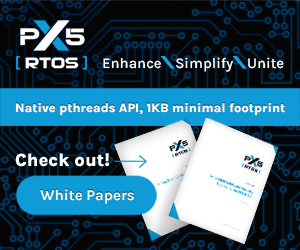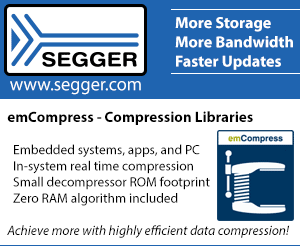
Episode 21: Review of ZeroPlus LAP F1 Logic Analyzer
February 2, 2018
(Go to the complete list of videos)
ZeroPlus is a Taiwanese company that makes test equipment. I had never heard of them till they sent me this logic analyzer. It's not cheap, but a heck of an instrument. Here's a review.
Video Transcription
I'm Jack Ganssle and welcome to the Embedded Muse Video Blog, which is a companion to my free embedded muse E-Newsletter. Today I'm going to do a review of the ZeroPlus LAP F1 Logic Analyzer. And at the end of this month, February 2018, I'm going to give this $7,500 Logic Analyzer away. Stay tuned at the end of the video to see how you could win it.
This is the unit itself. It's a really nice, heavy aluminum box. It really feels solid and robust. Here's where all the center leads go in or these USB connectors. There's a USB connection over to the PC with some triggering connectors and what not. Here is the DC input. It's powered from a wall wart, which is fine, except oddly, there's no power switch. I can't figure that one out at all.
I have four siblings, so when we were very small, on Christmas day, the Christmas tree was just packed with all kinds of presents. When this thing arrived from Taiwan, I couldn't believe all the stuff that came with it. All these connectors, all these probes. With 64 channels, it takes an awful lot of connectors to bring all those signals back to the unit.
This is what the probes look like. There's a type A USB connector that goes into the Logic Analyzer itself. And then, this little micro B super speed that connects to the sensor probe. And then, there's two kinds of probes. The first kind, the one I'm looking at here can sample two signals from your circuit, so there's the two inputs for it. This is a 120-megahertz probe. The thing also comes with some 200 megahertz probes, which are very much the same, except they can only handle one signal at a time.
Now, look at this.There's obviously a circuit board here. Out of curiosity, I cut the shrink wrap off of one of those and sure enough, this is what I found. A network of resistors, capacitors, and an IC. This is clearly an impedance matching network that allows you to propagate signals from your board, over the connector back to the logic analyzer. It comes with two different kinds of those connectors. This one is 30 centimeters long, which isn't very long. But the big one is two and a half meters. How many logic analyzers have you seen that can propagate a signal at 100 megahertz or more over two and a half meters? That's all because of the circuit on this board. Very, very clever.
Now, the 64 input channels are divided into 4, what they call ports. Each port handles 16 of them. And since you can have 2 signals per probe, you've got, of course, 8 USB connectors per port. You can set the voltage threshold on each of these ports separately, which is kind of nice. And what's sort of amazing, you can set it with a granularity of 10 millivolts, which I can't imagine why you would ever need to do that, but it's kind of cool.
The application has a pretty intuitive layout. You can see that you can set the depth of the memory here, right now it's set to 32K samples. I can crank it way up there. I'm at 8 million, 32 million. It'll go all the way up to 64 million right there. You can set the acquisition rate with this knob or with this nice strap down box here. Here I'm clicking at 100 megahertz rate. You can set the trigger position to anywhere inside the buffer. I can use this nifty control here to start an acquisition, which I'll do. And you can see, it's uploading all that data into the PC. Now, I didn't have a trigger condition set, so it's sort of a random acquisition. If I go to here and set a rising edge trigger, and then reacquire here, you can see it's capturing the data, uploading it. And I'll zoom out. Here, I'm collecting four different signals. There's the edge that caused the thing to trigger. This bottom window shows the entire buffer memory. The upper window is a zoomed in version of that, and you can, of course, pan that left and right and do all the usual navigation that you would expect. Here, I'm collecting all 64 channels, although there's only real signals on 4 of them.
One of the things I really like about this is it's sort of like a browser. You can add multiple tabs. So now, I've got another tab and I can conduct another acquisition, getting different kinds of data perhaps, different rates. See, I don't have a trigger set here. Or I can go back to the original one, and I still have all that information loaded there.
Like all logic analyzers, all different kinds of ways that you can configure the signals into different kinds of buses and what not. If I just picked some data and say, make a bus out of that, I can go to advanced setting tab, and what's pretty cool here is that you can actually cause any one of the inputs to the logic analyzer to be essentially the chip select for that bus, so that when this chip select comes along, that's when acquisition starts. Now obviously, you could also do that using a triggering condition, but this frees up some of your triggers so you can use them for more advanced purposes.
Look at all the protocol decoders that come in this thing. There's about 120 different protocol decoders, so all kinds of things. Some of this stuff I've never even heard of. Let's look at I2C. I click that. I can set which of these signals control which of the two I squared C signals. I can set the timing and actually it does this all graphically. So it's really flexible. I'm really impressed.
Another amazing protocol decoder, I don't even know what to call this thing, is this basic logic. You can actually design circuits. Here, I'm doing arithmetical logic with all these equations. This is an adder. This particular equation is an adder. It will actually decode that. You have all the sorts of different analysis automatically. Look here at some of the other ones, for example. Power, all kinds of power that can be figured out. Memory. Geez. Anything that you can think of, it's in there. It's very, very powerful.
I can go to this pattern trigger and define different kinds of patterns. So for example, I could pick A0 and give it a condition, whatever it might be. I can add different intervals. So for example, it's going to trigger if I select this one if there's some time parameter met, and there's a bunch of different options there. But what's really cool here is that I can add more conditions, and I can add more. So, for a trigger to happen, this has to be satisfied. Then, this has to be satisfied. Then, this has to be satisfied. You can see this changed here. This condition has to be met and then it goes to the next one here, and this next one causes the trigger to happen. I can do this all day long. As a matter of fact, I haven't tried it, but according to the manual, you can set as many as up to 256 of these things sequentially that have to happen before a trigger actually occurs. That gives you an incredibly fine view of what your system is doing.
Now of course, I said this stores 64 million samples per channel. What if that's not enough? They have an option, which is called long-term record, which spits the data compressed in real time up to your PC, so you can record essentially forever. Now, they do warn that you need a pretty fancy PC in order to do this because as you can imagine, there's a ton of data coming back up.
Last few years, I've seen an explosion of very inexpensive logic analyzers. Some of them are just a few hundred dollars. The Lap F1 is not one of those. This is an instrument with every possible feature and the price reflects that. The price actually ranges from about $2,500 to $5,500, depending upon the number of channels you order and a memory depth. If you want the longtime record feature, that adds another $2,000 to it.
They do make a line of less expensive logic analyzers, and they sent me one. I'll be reviewing that in the next month or two.
So there you have it. It's not cheap, but this is an insanely powerful logic analyzer and I'm very impressed by it. I'm giving this away. It's an incentive to fill out my salary survey. Go to Ganssle.com for more information. The contest closes at the end of February 2018, but if you miss it, there's plenty more. I run one almost every month. I give away everything from scopes to books to you name it. Thanks for watching and be sure to check out the thousand plus articles and other information about embedded systemes over at Ganssle.com.



